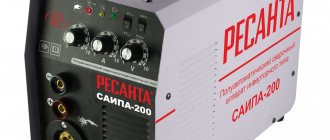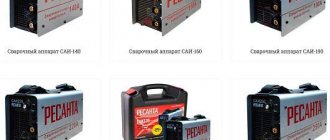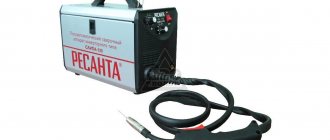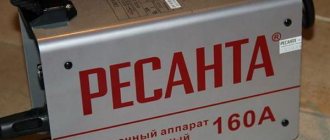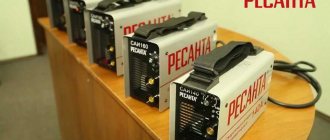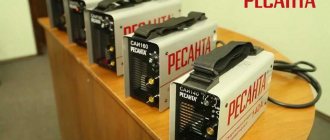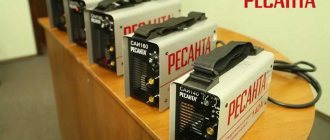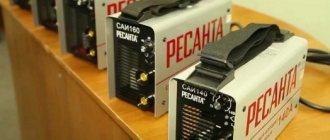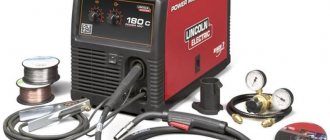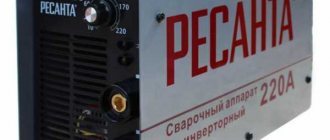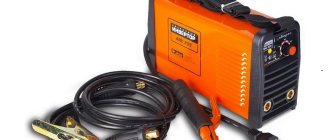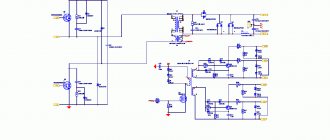What the article is about:
Review of semi-automatic welding machine RESANTA SAIPA 200
Semi-automatic welding machines from the Resanta company are modern equipment designed for welding using wire with a protective sheath. Semi-automatic machines are equipped with the latest functions and a modernized wire drawing system. All this makes working with Resanta semi-automatic machines convenient, and the quality of the welded joint always remains at its best.
Of all the models of semi-automatic welding machines, the most popular is the Resanta Saipa 200. A welding current of 200 amperes guarantees the completion of most household and industrial work, allowing you to weld both a thin car body and thick metals, the thickness of which reaches 6 mm.
In this article you can learn about the characteristics of the Resanta Saipa 200 inverter semi-automatic machine, as well as read reviews from those who have been using such a semi-automatic machine for a long time.
General information
Connecting metal parts to each other makes it possible to realize even the most complex projects. Semiautomatic welding machines can be classified as single-phase devices that perform welding operations at direct current. As for the Resanta SAIPA-165 brand apparatus, welding occurs using wire , which melts in a gas environment. A rather big advantage of semi-automatic welding is that the wire and gas are supplied from the torch simultaneously, unlike a conventional welding machine that uses electrodes.
In semi-automatic machines there is no need to maintain a constant gap between the metal and the wire, since the wire is fed automatically.
Another strength of the semi-automatic welding machine is that it is possible to work with fairly thin metal without burning holes. The welding device has an adjustable wire feed speed , which makes the robot quite easy. If the metal is thick, then you can set the amperage higher and the wire feed speed higher, which will speed up the welding process.
How is semi-automatic welding carried out?
As in other types of welding, before starting work, you need to make sure that the parts have been pre-treated - degreased and cleaned. Before starting work, connect the ground cable to the welding table and check the extension of the welding wire. If the wire is longer, you need to cut it off with side cutters.
HELPFUL ADVICE.
It is important that the tip of the wire is sharp - then it will be easier to light the arc. During the welding process, before each new seam, the tip (or the resulting ball) of the wire will need to be bitten off - this will make the start of the new stage easier.
Like any type of welding, semi-automatic welding begins with ignition of the arc. To do this, the welding wire must touch the surface of the part being welded. We press the torch button - the supply of welding wire and shielding gas begins simultaneously.
The arc is ignited. The welding process is taking place. To extinguish the arc, you need to release the button and move the torches away from the work being welded.
The torch can be operated with one hand, but when using two hands the seam will be more accurate and control over the process will be more confident. You need to grab the burner with one hand, your index finger should be at the bottom of the start button. You can lean on your other hand with your leading hand - this will make it easier to control the distance to the surface to be welded and the angle of inclination, as well as make the necessary movements with the torch.
There is no universal welding torch angle that must be observed when welding. If we cook parts in the same plane and both parts are of the same thickness, then the burner can be held vertically. If the parts are different in thickness, then the tilt should be made towards the part with a smaller thickness. When welding two parts at an angle, it is more convenient to hold the torch at an angle of 5-25% degrees (from the vertical). The distance from the nozzle to the surface to be welded is from 5 to 20 mm.
The movement of the burner can be either forward or backward. When welding at an angle backwards. With this method, the depth of penetration and the height of the seam increases, its width decreases. When welding at an angle forward, the edges are better fused, the penetration depth is reduced, but the seam is wider. This method is good for welding metal of small thickness.
During the welding process, you will choose the most convenient and comfortable welding style for you - from the way you hold the torch to the parameters of the machine. Also pay attention to the sound of the arc - it will help you adjust the settings. Thus, a correctly installed arc has a smooth hissing sound. If you hear a cracking sound, then most likely there is an imbalance between feed speed and voltage, or poor contact in the welding area.
The influence of torch speed on seam quality
The quality of the weld also depends on the welding speed - the speed at which the electric arc passes along the welding site. The speed of the welding torch is controlled by the welder and affects the shape and quality of the weld. Over time, you will learn to determine the speed by looking at the thickness and width of the seam during the welding process:
- Too high a speed is accompanied by increased metal splashes. The seam is thin and intermittent.
- A speed that is too slow will produce a wide, blurry seam.
How to move the welding torch during semi-automatic welding?
There are many ways to move the torch to form a seam:
- For metals 1-2 mm thick, you can move the torch in a zigzag pattern to act with an arc on both sheets being welded - then the result is strong and airtight. In addition, with this method, the electric arc does not penetrate the metal.
- If you have some experience, use a straight seam, without any oscillatory movements. This weld can be used to weld metals of any thickness, but here it is important to feel that the arc evenly covers both workpieces.
- When you need to make a long seam, in order to prevent overheating of the metal and thermal deformation, you can weld in small segments from one or the other end of the parts being welded. This will allow the entire segment to be welded without thermal deformation of the sheet metal.
Features of the device
First of all, the device has an ergonomic design. Quite convenient regulators, which are controlled with minimal power consumption. During welding, the arc is uniform, which prevents the wire from sticking. The Resanta Saipa-165 device has overheating protection ; as soon as the device overheats, the protection will automatically work and de-energize the semiautomatic device. The features of the model include a strong and reliable ground wire, which ensures proper contact.
The semi-automatic device has built-in special protection against power surges, which is a definite plus. The presence of the “forced arc mode” function, which saves parameters as the arc distance increases, also makes it easier for the robot. The machine can use welding wire with a diameter of 0.6−0.9 mm, which allows you to make a high-quality and durable seam of thin metal.
There is another newer model, this is the “Saipa 220” inverter, the model is also manufactured in Latvia. The inverter can be used both in professional and amateur welding.
Technical characteristics and equipment
Compared to other semi-automatic machines, the Resanta Saipa 165 looks quite decent, thanks to its improved ergonomics. The technical characteristics of the device are as follows:
- It is possible to choose welding in a gas environment or without it.
- Wide range of welding current changes from 20 to 160 A.
- Use wire with a diameter of 0.6 to 2 mm.
- Relatively small weight of the device, amounting to 11.5 kg. Dimensions - 60.5x24x37 cm.
- The power is 4.7 kW per hour.
- It is possible to cook with electrodes.
The Resanta semi-automatic machine is mainly used for welding cars and spot welding, but it is not designed to work with large areas. When welding, it is necessary to compare the diameters of the wire with the welding current and the wire feed speed. As for the technical characteristics of the Saip 220 , they are slightly better than those of the Saip 165 model, and look as follows:
- The ability to adjust the welding current from 10 to 220 A, which allows you to work with thicker metal.
- Ability to perform welding work even if the input voltage is 154 V.
- At peak load, the inverter consumes 30 A.
- The diameter of the welding wire ranges from 1.6 to 5 mm.
- Quite a high protection class IP 21, which will allow you to work in various adverse conditions.
- Weight is 4.9 kg.
The strength of this semi-automatic machine is the ability to work with thick metal, and for quite a long time. "Resanta" semi-automatic "Saipa 220" inverter can work in places where the voltage is quite low. The device can easily withstand heat and rain, and due to the above characteristics of the “Saipa 220 Resanta”, the semi-automatic inverter welding machine has only positive reviews.
The cost of the device is quite high, and the equipment is minimal. The user who purchases a welding device of this model will receive only the necessary components for welding. The kit includes a burner, ground wire, and documentation for the device. There is no case for consumables, no welding shield and no brush for stripping metal. The price varies from 17 to 20 thousand rubles.
Semi-automatic welding machine Resanta SAIPA-200
The semi-automatic welding machine Resanta SAIPA-200 is designed for manual electric arc welding with direct current wire in a shielding gas (carbon dioxide, argon or a mixture of them), without gas (with flux-coated wire), as well as for manual electric arc welding with direct current coated electrode (MMA). This device can be used in both the household and industrial segments.
Specifications
| MIG/MAG welding current adjustment range: | 30…200 A |
| MMA welding current adjustment range: | 15…200 A |
| Maximum power consumption: | 6.6 kW |
| Maximum current consumption: | 30 A |
| Input voltage range: | 140…270 V |
| Recommended wire diameter: | 0.8…1 mm |
| Maximum electrode diameter: | 5 mm |
| Welding torch: | removable |
| Length of cable with electrode holder: | not included in delivery |
| Ground cable length: | 1.5 m |
| Duration of loading: | 70% at welding current 200 A |
| Arc voltage: | 15.5…23 V |
| Anti-stick protection: | ANTI STICK function |
| Overheat protection: | automatic |
| Hot start function: | There is |
| Cooling: | forced |
| Protection class: | IP21 |
| Ambient temperature: | -10…+40 °С |
| Overall dimensions, L×W×H: | 560x200x330 mm |
| Weight, no more: | 14.4 kg |
| Warranty period: | 24 months |
Principle of operation
The power source is an inverter based on IGBT transistors. The operating principle of the inverter is to convert alternating mains voltage with a frequency of 50 Hz into a direct voltage of 400 V, which is converted into high-frequency modulated voltage and rectified. Welding occurs with a consumable electrode in a shielding gas environment. The electrode is a metal wire wound on a spool, fed into the welding zone by an adjustable drawing mechanism. Shielding gas is supplied to the welding zone from the attached cylinder through an electromagnetic valve. The device has built-in overheating protection and is equipped with adjustments for the current value and welding wire feed speed depending on the material and thickness of the workpiece being welded.
Device SAIPA-200
The product is made in a metal case with an opening side cover, on the front panel of which there is:
- Button for switching between MIG/MAG and MMA modes.
- Arc voltage regulator for MIG/MAG mode (this adjustment is only for MIG/MAG mode).
- Welding current and wire feed regulator for MIG/MAG mode and welding current regulator for MMA mode.
- Arc force regulator.
- Forced drawing of welding wire.
- Power connectors for connecting welding cables.
- The “network” indicator lights up when the device is turned on.
- The “overheating” indicator lights up for a few seconds when the device is turned on and when the device overheats, and turns off after it has cooled to operating temperature.
- Circuit breaker. It allows you to work in networks with weak wiring and networks that are not equipped with protection (installed on the rear panel).
Welding current strength
As the welding current increases, the penetration depth increases, which leads to an increase in the proportion of base metal in the weld. The width of the seam first increases slightly and then decreases. The strength of the welding current is set depending on the selected electrode diameter.
Wire feed speed
It is related to the strength of the welding current and is regulated simultaneously with it. It is installed in such a way that short circuits and arc breaks do not occur during the welding process.
Arc voltage
As the arc voltage increases, the penetration depth decreases and the weld width increases. An excessive increase in arc voltage is accompanied by increased spattering of liquid metal, deterioration of gas protection and the formation of pores in the deposited metal. The arc voltage is set depending on the selected welding current.
Electrode stick out
With increasing electrode extension, the stability of arc combustion and weld formation deteriorate, and the splashing of liquid metal also increases. A very small overhang makes it difficult to observe the welding process and causes frequent burning of the torch gas nozzle. The amount of electrode extension, as well as the distance from the burner nozzle to the metal surface, is set depending on the selected diameter of the electrode wire.
| Electrode wire diameter: | 0.5-0.8 mm | 0.8-0.1 mm |
| Electrode stick out: | 7-10 mm | 8-12 mm |
| Distance from nozzle to metal: | 7-10 mm | 8-12 mm |
| Carbon dioxide consumption: | 10-15 dm3/min | 10-15 dm3/min |
Hot start (HOT START)
To ensure better ignition of the arc at the beginning of welding, the inverter automatically increases the welding current. This will greatly facilitate the start of the welding process. Thanks to this function, the device can be used not only by experienced welders, but also by beginners. This function is installed on all Resanta welding machines.
Anti-stick (ANTI STICK)
When starting welding, the arc must be ignited. This often leads to the electrode sticking to the product. In this case, the inverter itself automatically reduces the welding current, and the electrode easily comes off. Subsequently, after the stuck electrode comes off, the inverter resumes the set welding parameters. All SAI series welding machines are equipped with this function.
| Electrode diameter | Current |
| 1.6 mm | 25-50 A |
| 2 mm | 50-70 A |
| 2.5 mm | 60-90 A |
| 3.2 mm | 90-140 A |
| 4 mm | 130-190 A |
| 5 mm | 160-220 A |
| 6 mm | 200-315 A |
PV (on duration)
The meaning of the “PV” parameter is as follows: this is the time during a 10-minute interval that the device is capable of operating at the specified current. This means that for 70% of a 10-minute interval (that is, 7 minutes), the device can continuously cook without breaking the arc at the specified current, and for the remaining 3 minutes it must “rest” at idle, and the device cannot be turned off from the network, so that forced cooling (fan) works.
Equipment
| Welding machine: | 1 PC |
| Torch cable: | 1 PC |
| Cable with ground terminal: | 1 PC |
| Manual: | 1 PC |
| Package: | 1 PC |
Documentation
Passport for welding machine Resanta SAIPA-200
Certificate of conformity for Resanta welding machines
Dear buyer!
The manufacturer sets the official service life for inverter welding machines to 5 years, subject to compliance with operating rules. The Resanta Trading House expresses its deep gratitude to you for your choice. Our company has done everything possible to ensure that this product satisfies your needs, and the quality corresponds to the best world standards.
Auxiliary equipment
Due to the fact that the welding kit comes with quite a few consumables, as well as personal protective equipment, the user will have to spend money on various additional materials after purchase. A wide range of additional equipment can be found on the market. One of the elements is welding wire of various diameters; if possible, it is also necessary to purchase welding electrodes.
You will also have to purchase a gas cylinder. A brush for cleaning various surfaces will be useful, and for a normal gas supply you need to take a pressure reducer. In the Resanta 165 inverter semi-automatic machine, the pulse feeder often fails, which you will also have to buy or repair yourself.
